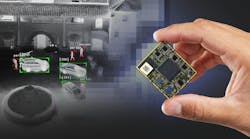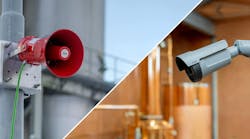This article originally appeared in the December 2023 issue of Security Business magazine. When sharing, don’t forget to mention Security Business magazine on LinkedIn and @SecBusinessMag on Twitter.
When designing a physical security system to protect critical assets, the objective is simple: Secure buildings and assets from theft, vandalism, property damage, unauthorized access, and so on. Implementing an effective security system that performs reliably requires careful planning.
While most traditional physical security systems perform well in ideal conditions, inclement weather, uneven terrain, unfavorable lighting and remote locations can often affect a system’s ability to deliver clear images and reliably detect potential intruders.
Legacy PIDS technologies, such as buried cables, fence detection systems, and microwave sensors can be costly to install and often do not provide optimal situational awareness, as many of them are designed to alert security personnel to an ongoing intrusion, rather than provide advanced warning of a potential intrusion event. These devices are also notorious for generating false alarm events, which waste time and resources.
Even top-tier visible cameras offer limited performance under certain environmental conditions, such as heavy fog, wind, rain, and snow. For these reasons, integrators should consider adding thermal cameras to their perimeter intrusion detection system (PIDS) designs. The most reliable PIDS devices deliver high quality, clear images, regardless of adverse weather or lighting scenarios. When building a perimeter security system for customers that includes thermal cameras, issues like sensitivity and standards compliance are also key considerations.
Here are four key best practices for integrating thermal cameras into new or existing PIDS:
1. Consider environmental conditions and identify what your customer needs to protect most.
When it comes to choosing which devices to deploy, not all technologies are created equally. Erecting a chain-link fence and deploying exterior lighting, for example, may be effective for crime deterrence, but stopping there can create a lot of room for error. Integrating visible cameras to provide early warning of a perimeter intrusion vastly improves situational awareness; however, integrators designing a solution for a remote facility that features limited existing installation infrastructure, uneven terrain, inclement weather, or unfavorable lighting conditions should consider thermal sensor technology built to operate reliably in all conditions and during all hours of the day.
2. Understand the product specifications each deployment will need.
It is also important to consider the product specifications that meet a deployment’s specific requirements. For example, those familiar with visible cameras understand that resolution and available pixels determine how well analytics will work for a customer’s necessary application. When choosing a thermal camera that is right for an application, it is important to understand Noise Equivalent Temperature Difference (NETD) – or thermal sensitivity – namely how it impacts a thermal camera’s performance.
Since a more sensitive thermal camera can see smaller changes in temperature, the image the camera produces will ultimately provide better clarity, resulting in better overall performance. Highly sensitive thermal cameras can also detect changes in temperature more quickly and with greater accuracy, leading to increased efficiency identifying, detecting and classifying objects at farther distances, resulting in a lower rate of nuisance alarms.
3. Ensure ONVIF and NDAA compliance.
For new and existing deployments alike, products compliant with ONVIF standards can work together, regardless of brand. This helps to simplify installation and reduce costs by allowing customers to mix and match different cameras and video management systems from different manufacturers.
It is also important to work with manufacturers that are committed to implementing security measures to protect their customers' information, such as data encryption, multi-factor authentication, regular risk assessments and NDAA compliance. The NDAA has prioritized security cameras, making it crucial for organizations – especially those working with the U.S. government – to ensure their security equipment is NDAA compliant.
4. Explore options to install cameras with edge analytics and internal device communications capabilities.
Thermal cameras that include onboard video analytics and device-to-device communication for continuous site monitoring and real-time intrusion alerts cut down the time it takes for PIDS to detect and deter crime significantly. Not only do these devices circumvent the need for additional software, but they also enable intelligent target tracking between networked devices and directly stream information to a video management system (VMS), alerting operators to potential targets and maintaining constant eyes on threat until security teams can intervene.
Advanced analytics are also designed to intelligently filter false-positive activity, such as small animals or wind-blown foliage, while they monitor for, recognize, and classify human and vehicular intruders, ultimately resulting in more reliable threat detection with fewer nuisance alarms.
Malinda D’Amico is a Senior Regional Marketing Manager at Teledyne FLIR.


